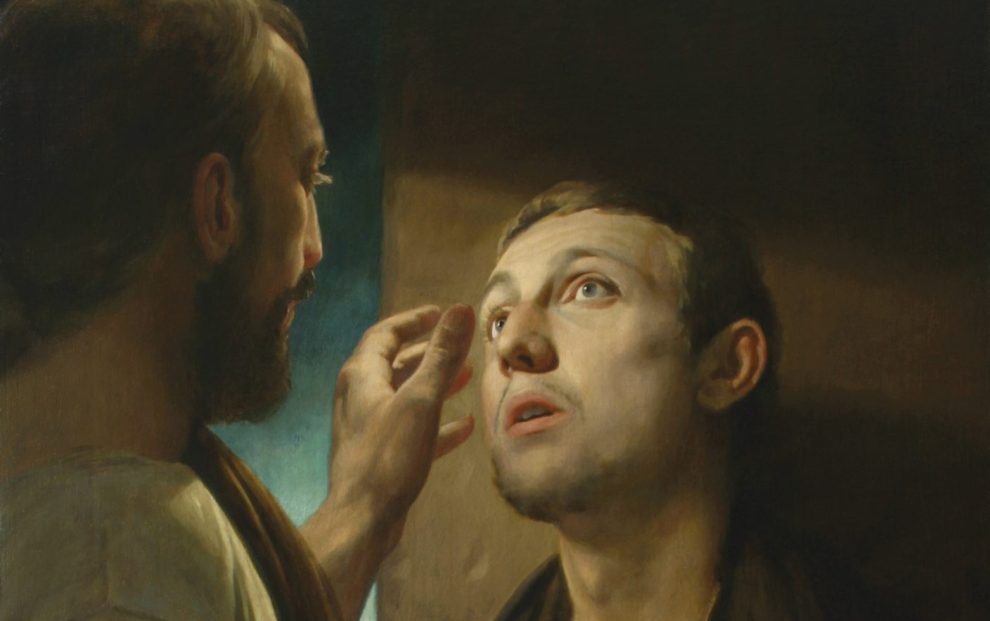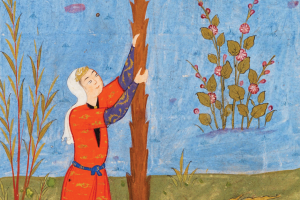“The Spirit of the Lord . . . has sent me to proclaim release to the captives and recovery of sight to the blind, to set free those who are oppressed, to proclaim the year of the Lord’s favor.” (Luke 4:18–19)
Are you a hopeful person? Is it possible to become one if hope’s not your signature attitude?
This is the question of the year, since Pope Francis designated 2025 as the Jubilee for Pilgrims of Hope. Also known as a holy year, this Jubilee began Christmas Eve 2024, when the pope opened a door in St. Peter’s Basilica that’s only unsealed during holy years.
Before we go further, what exactly is a Jubilee? The Hebrew word from which it derives means goat, oddly enough. Ancient Israel announced a Jubilee every 50 years by blowing the shofar, which is a ram’s horn.
A Jubilee was a “year of the Lord’s favor,” a.k.a. a time for community-wide justice. This implied, among other things, that debts were forgiven, indentured servants were given their freedom, and land confiscated for a variety of reasons was restored to its original owners.
It’s impossible to say if Jubilees were ever enacted as frequently and scrupulously as Mosaic law outlined. They wouldn’t have been good news for wealthy enslavers and landowners, obviously. They would have made procuring loans in the years preceding the 50th year nearly impossible to do.
Christianity put a new spin on Jubilee: not as a time to erase monetary debts but to remit sins. The first Christian Jubilee was in 1300, when Pope Boniface VII declared it should be celebrated every 100 years.
People liked the first one so well, though, that in 1342 the practice was adjusted to occur every 50 years. In 1389, Urban VI piously preferred to observe a 33-year cycle of holy years to honor the presumed duration of the life of Jesus. Despite differences of opinion about when they ought to occur, Pope Boniface IX celebrated a Jubilee in 1400.
Pope Martin V instituted the practice of opening a holy door to inaugurate the year. After this, Jubilees returned more or less to the 50-year cycle, interrupted by a few European wars in the 1800s. These days, Jubilees are observed every 25 years or whenever the pope determines to have one.
What are we to do in a Jubilee year? Considered a time for pilgrimage, the most complete observance is to take a pilgrimage to Rome. From the earliest Christian Jubilees, passage through the holy door granted the pilgrim a plenary indulgence (full pardon for their sins).
Since a trip to Rome isn’t possible for many Catholics, each diocese is urged to open its own holy door so more people can participate. Some parishes even designate their own ceremonial Jubilee door so that anyone can ritually claim pilgrimage right where they live.
In more recent times, Jubilee years have engaged thematic emphases. In 1900, Pope Leo XII called for an awakening of faith among Christians. Pope Pius IX summoned the church to work toward a better society in 1925. Pius XII pulled out all the stops by announcing the dogma of the Assumption of Mary in 1950—and expanding the college of cardinals to represent the world outside of Italy. The first post-Vatican II Jubilee, held by Pope Paul VI in 1975, was dedicated to worldwide reconciliation. Buddhist monks were among the first pilgrims through the holy door.
St. Pope John Paul II celebrated the 2000 Jubilee for the forgiveness of history’s great sins and included many gestures of interfaith reconciliation. Pope Francis called for a Holy Year of Mercy in 2015. And now, this Jubilee Year 2025, it’s time for all Catholics to take a pilgrimage of hope in a post-pandemic world that could surely use a fresh infusion of it.
What is hope to a Christian? First, it’s one of three theological virtues along with faith and love. St. Paul declared these the “three things that last” when all else falls away. They last because they unite us with God—hence the term “theological” virtues.
The gravity of this idea suggests that Christian hope is more than cockeyed optimism. It’s not just being upbeat about the future when others lack enthusiasm. The theological virtues not only orient us to God, they also originate in God. In plain English, we’re hopeful about our future destiny in God. And we can’t be hopeful about this without divine help.
Christian hope is also contrasted with the twin vices of despair and presumption. Despair belongs to those who feel they’re so lost they can never find their way back to God. Despair can also belong to their loved ones who are sure those who leave the church—whether through a deliberate disavowal or a simple falling out of practice—are outside God’s mercy for good.
Presumption, the other counter-vice to hope, is the delusion that we earn our way to God by doing certain things: performing good works, accumulating sacraments, stockpiling prayers and pieties. Or, conversely, by not doing certain things: the so-called impure thoughts and actions, traditionally those of a sexual nature.
Hope puts the lie to this fractured thinking. Longing for union with God means longing with God for a world of justice, peace, and compassion. These grander goals take our gaze off our personal vices or virtues so we can see with a God’s-eye view.
Hopeful people move toward this visionary world despite the many obstacles to these goals. Yet Christian hope is realistic, as Dominican theologian Vivian Boland points out. Hope admits the difficulty and suffering in our present reality. Still, it maintains courage in failure or disappointment because Jesus Christ has overcome the world.
Jürgen Moltmann even goes so far as to say that it’s only in those situations that seem to contradict hope—suffering, evil, loss, and death—that genuine hope is realized. We can’t really be hopeful when all is going well since our faith isn’t challenged. It’s only when things fall apart around and within us that hope is born and can be exercised.
Apocalyptic climate change, war and violence, widespread addictions, racist structures, a lopsided economy, fear and mistrust of outsiders—I’d say we have plenty of reasons to give birth to hope in our generation. Being pilgrims of hope in this Jubilee year 2025 is going to require of us much more than walking through a doorway.
This month, the Sunday of the Word of God (January 26) is also marked this holy year as a celebration of the world of communications. Rome issues a special invitation to pilgrims who are broadcasters, journalists, writers, or media workers of every kind. Since we’re all potential communicators of hope in our social media and personal presence, we can participate right where we are.
You might keep a hope journal, recording hopeful quotes, courageous stories, and clipped articles of positive breakthroughs. You can invite others to view inspiring movies and documentaries, and less of the dystopian stuff. Resist the click bait of inflammatory pseudo-news that’s aimed at selling ad space. We can pray every morning to be better pilgrims of hope as we move through situations and contexts of our day. Even if hope isn’t presently your thing, be open to receiving this grace.
This article also appears in the January 2025 issue of U.S. Catholic (Vol. 90, No. 1, pages 20-24). Click here to subscribe to the magazine.
Image: Christ and the pauper, A.N. Mironov. Wikimedia Commons.












Add comment